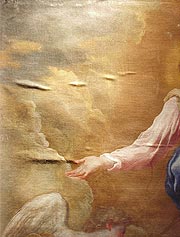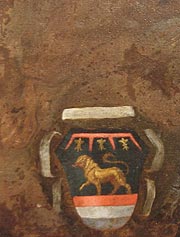What's Wrong with this Painting?
Although it may appear to be a static object, Castiglione's Immaculate Conception with Saints Francis of Assisi and Anthony of Padua has undergone changes due to aging, deterioration, and damage in the 350 years since its creation. These ongoing changes have necessitated restoration measures in the past, and thus the treatment you are viewing here may be the painting's third or fourth major conservation. Even though a painting and the materials added during conservation age as one, the materials added to the Castiglione during old restorations have become problematic. All of the above factors have produced condition problems that fall into two categories, structural and cosmetic.
 
Structural Condition
The present lining fabric, attached to the reverse of the original canvas with a water-based glue-paste, is failing to support the painting. In large areas, the original canvas and the lining fabric have separated because of the fabric's deterioration and the degraded adhesive. Furthermore, there is little tension on the canvas, which is now sagging under its own considerable weight and large bulges have developed.

Cosmetic Condition
The present varnish and old retouchings detract from the painting's appearance. The varnish--a modern synthetic resin--has discolored to a grayish tint and has dirt embedded in it. The gloss is uneven, and the varnish does not fully saturate the paint layers. Losses in the paint and ground layers have been poorly filled and textured. There are at least two generations of retouching to conceal abrasion, losses, and other disfigurements. In the older retouching, an oil medium was applied as a flat field of color with no attempt to reconstruct missing areas of the design. The synthetic medium used in the more recent retouching has blanched and no longer matches the original paint layers.
|
